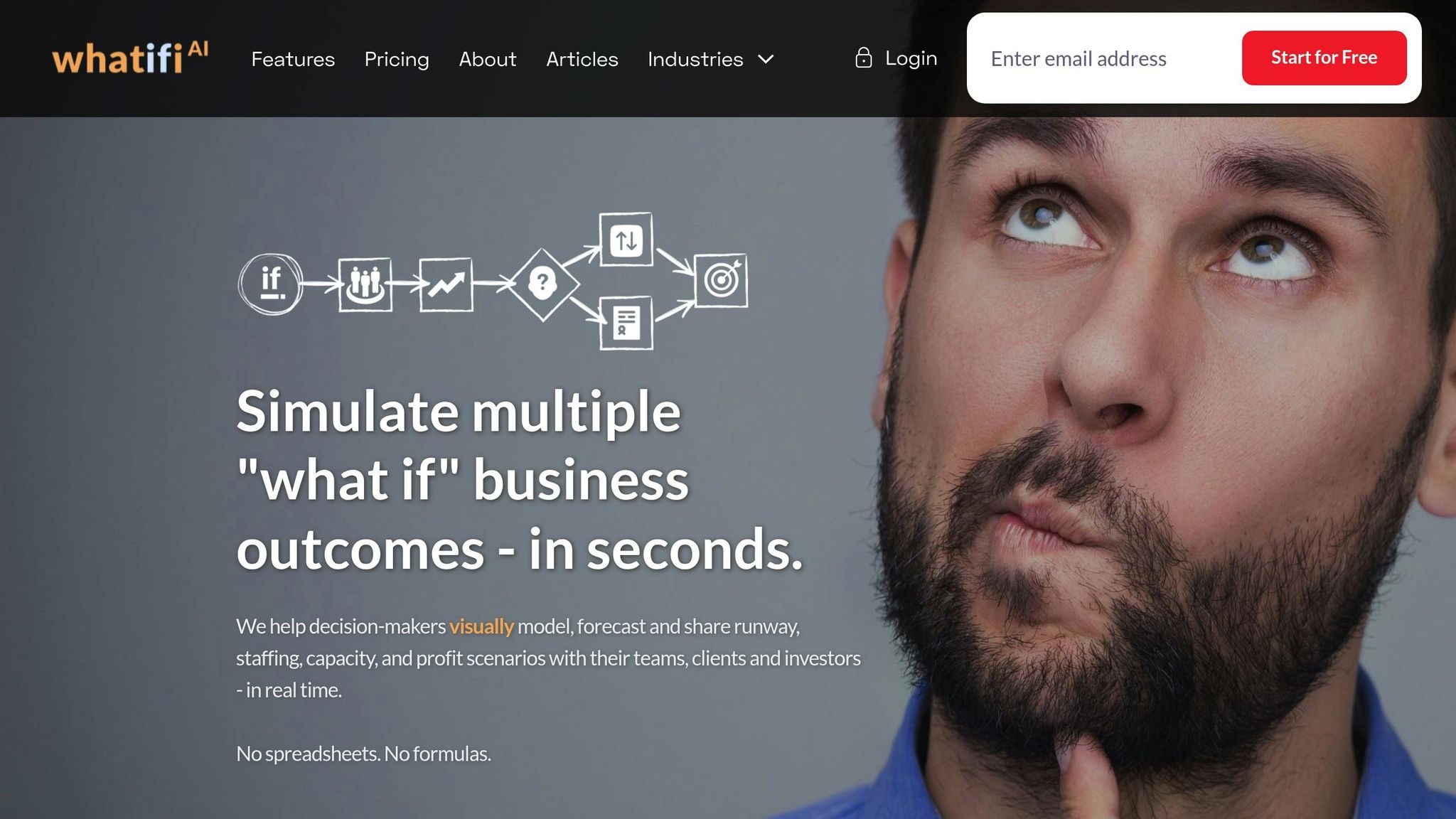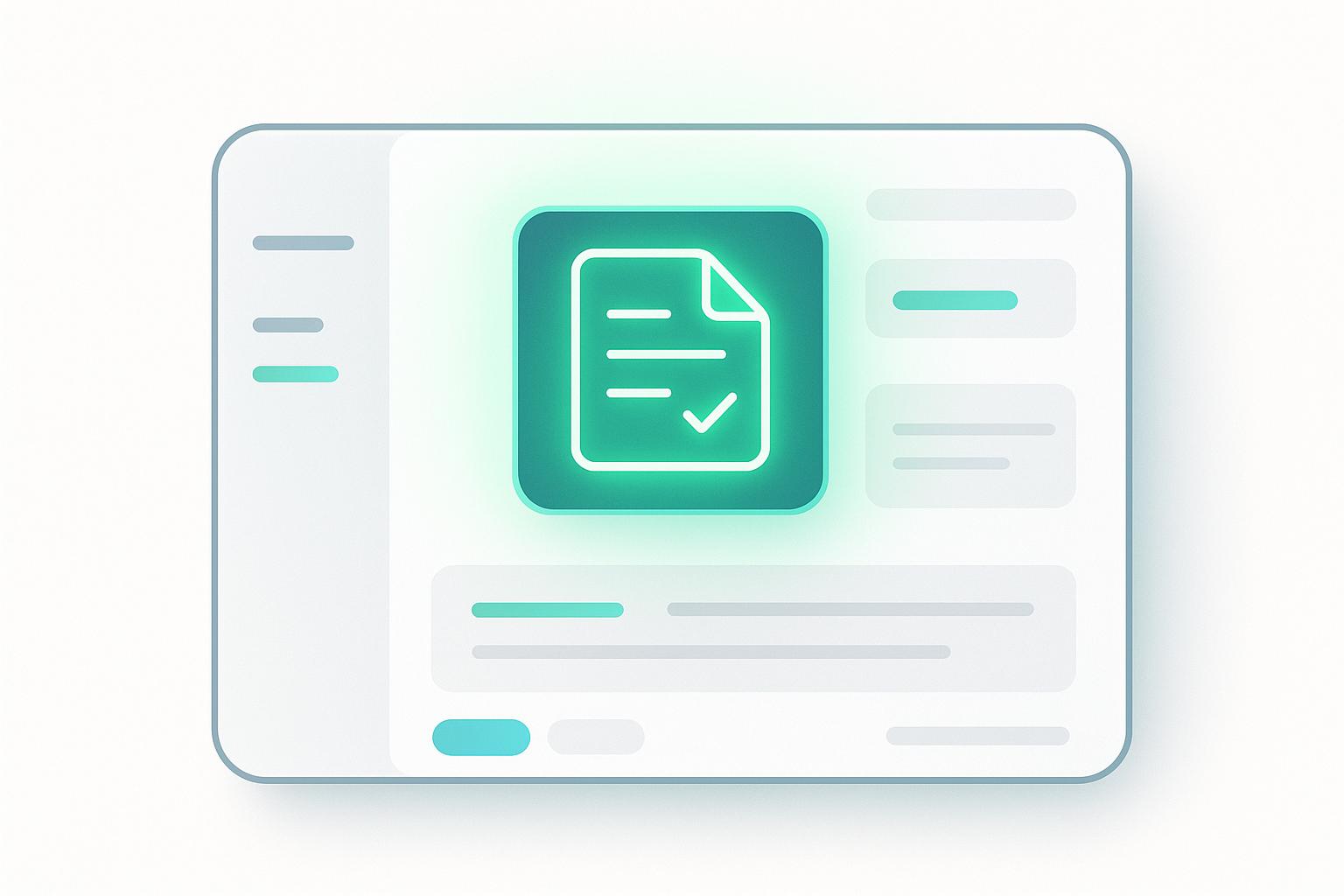AI is transforming how businesses, especially startups, handle scenario-based expense planning. Instead of relying on outdated spreadsheets, AI tools bring speed, accuracy, and flexibility to forecasting. Here's what you need to know:
- Scenario Planning Basics: Create multiple "what-if" scenarios to prepare for different business conditions, like rapid growth or cautious spending.
- AI's Role: Automates calculations, updates forecasts in real-time, and manages complex interdependencies between variables like revenue, hiring, and operational costs.
- Key Features: AI tools use historical data to predict expenses, adjust scenarios dynamically, and integrate with financial systems for real-time updates.
- Benefits: Faster forecasts, reduced human error, and better insights into expense drivers like customer churn or marketing spend.
- Challenges: Requires quality data, can struggle with unprecedented events, and shouldn’t replace human judgment.
AI tools like Lucid Financials simplify planning by connecting with platforms like QuickBooks and Stripe, offering real-time answers, and helping startups make informed decisions about growth, spending, and fundraising. While AI enhances efficiency, it works best as a complement to sound financial strategies.
Whatifi Demo: Visual Scenario Planning with AI-Powered Financial Modeling and Business Intelligence

How AI Changes Scenario-Based Expense Planning
AI has transformed how startups approach expense planning by automating complex calculations and updating multiple scenarios in just minutes. By processing hundreds of variables, AI delivers fast, precise forecasts that adjust as conditions evolve.
One major advantage is the elimination of human error in manual planning. For instance, if a startup wants to estimate the costs of hiring 20 new employees over six months, AI can automatically calculate everything - salaries, benefits, equipment, and office space - while factoring in all related dependencies.
AI-Powered Forecasting Tools and Features
Modern AI tools leverage machine learning algorithms to analyze historical spending data and predict future expenses across different scenarios. These systems learn from your company’s actual data, uncovering trends and seasonal patterns that might be missed by human planners.
They also generate projections for best-case, worst-case, and baseline scenarios. For example, when planning customer acquisition costs, AI might simulate a best-case scenario where conversion rates improve by 15%, a worst-case where they drop by 10%, and a baseline where performance remains steady. All related expenses adjust automatically across these scenarios.
Another game-changer is automatic forecast updates. As monthly expenses roll in, AI recalibrates its models in real time. If marketing spend exceeds the plan by 20%, the system immediately updates future forecasts, adjusting projections for lead generation, sales staffing, and onboarding costs accordingly.
AI tools are also skilled in sensitivity analysis, pinpointing which variables have the greatest impact on your expense projections. For example, a SaaS startup might find that a 10% change in customer churn rate has a bigger effect on support costs than a 20% change in new customer acquisition. This insight helps founders focus on metrics that matter most.
Another strength lies in modeling interdependencies between expense categories. If revenue grows faster than expected, AI calculates the ripple effects: increased customer support needs, higher server costs, additional sales staff, larger office space requirements, and expanded marketing budgets. These adjustments happen automatically, without manual input, and the models continuously refresh with live data.
Real-Time Data Integration
AI takes forecasting to the next level by integrating with your financial systems to keep projections current. This real-time data integration ensures your expense scenarios are always based on the latest information.
AI-powered systems connect seamlessly with tools like QuickBooks for accounting, Stripe for payments, and banking platforms. Through API connections, data flows in automatically, eliminating the delays caused by manual spreadsheet updates. When expenses or payments occur, the system instantly incorporates them into its models.
The integration also strengthens data validation. AI can flag unusual expenses, duplicate entries, or inconsistencies. For instance, if marketing costs spike unexpectedly or a vendor payment seems out of place, the system alerts you immediately, preventing errors from snowballing.
Platforms like Lucid Financials enhance integration by linking with communication tools like Slack. Founders can ask real-time questions about their expense scenarios and receive instant answers from the AI system, turning scenario planning into an ongoing, interactive process rather than a quarterly task.
AI also excels at multi-source data consolidation, combining inputs from various tools into a single forecasting engine. Sales data from your CRM, expense data from accounting software, and operational metrics from business intelligence tools all feed into one system. This comprehensive view allows for more precise scenario modeling than relying on isolated data sources.
The real-time capabilities enable dynamic scenario adjustments. If market conditions shift or a major client churns, you can immediately see how this affects your expense forecasts for the next year. This agility helps startups make quicker decisions about hiring, spending, and resource allocation based on current realities rather than outdated assumptions.
Step-by-Step Guide to AI-Driven Scenario Planning
Starting with AI-driven expense planning requires aligning your business goals with what AI can deliver. The idea is to follow a structured process that uses AI's strengths while keeping your objectives front and center. Building on AI's forecasting capabilities, here's how you can integrate scenario planning into your strategy.
Define Objectives and Key Variables
Before diving into AI tools, clarify your goals and identify the factors driving your expense scenarios. Are you planning for fundraising, hiring, or market expansion? Once you've nailed down your primary objective, list the key expense drivers, such as revenue growth, acquisition costs, and churn rates.
Set a planning timeframe and outline three scenarios: optimistic, realistic, and conservative. For instance, if your baseline assumes 15% monthly revenue growth, your optimistic scenario might project 25%, while the conservative one plans for 8%. Define specific assumptions for each scenario.
Next, consider how expenses scale with revenue. For example, if revenue grows faster than expected, which costs will rise proportionally? Often, customer support, server infrastructure, sales commissions, and office space increase alongside revenue growth. AI is excellent at modeling these relationships, but you need to identify them first.
Don't forget external factors like economic conditions, industry trends, regulatory shifts, and competitive pressures. While AI can process historical data on these elements, you'll need to provide context about current market dynamics and anticipated changes. Clear objectives make it easier to fine-tune AI models.
Use AI Tools to Model Scenarios
Once you've defined your goals and variables, it's time to let AI build your expense models. AI platforms can handle multiple scenarios at once, adjusting hundreds of expense items based on changes in your key variables.
Start by inputting 12 months of detailed financial data, including expense categories, revenue figures, and operational metrics like headcount and customer numbers. This data allows the AI to recognize patterns and relationships.
Next, set your scenario parameters. Input your growth assumptions, hiring plans, and market conditions for each scenario. Tools like Lucid Financials allow you to make these adjustments using natural language commands in Slack, making it simple to test different assumptions quickly.
Have the AI generate projections for each scenario. The system will calculate expense forecasts across all categories, factoring in the interdependencies you've outlined. Review these outputs to ensure they align with your business logic, and make adjustments as needed.
Use sensitivity analysis to identify your most critical expense drivers. This helps you focus on the metrics that matter most. For example, if a 10% increase in customer acquisition costs has a greater impact than a 20% rise in office rent, you'll know where to direct your attention.
Experiment with individual variable adjustments to see their overall impact. For instance, how does a 30% increase in marketing costs affect your cash runway? Or what happens if hiring is delayed in Q2? AI tools can answer these questions instantly, saving you from manual recalculations.
Analyze Results and Develop Strategies
Once you have your expense projections, turn them into actionable strategies. Start by comparing cash runways across scenarios - say, 8 months versus 18 months - to assess financial risks and determine buffer requirements. These insights can guide decisions around fundraising and spending.
Look for expense inflection points where costs spike significantly. AI often highlights how hitting certain growth milestones can lead to steep expense increases. For instance, reaching 100 customers might require more customer success staff, while crossing $1 million in annual recurring revenue might demand enterprise-level infrastructure upgrades.
Develop contingency plans based on your analysis. If your conservative scenario shows a concerning cash burn rate, plan ahead. Decide which marketing channels to pause or how quickly you can delay hiring. Having these steps outlined in advance allows you to respond swiftly to changes.
Use AI insights to optimize resource allocation. For example, sensitivity analysis might reveal that spending an extra $10,000 per month on customer success reduces churn by 2%, ultimately saving $50,000 in customer acquisition costs.
Set up monitoring dashboards to track your actual performance against AI projections. Create alerts for when key metrics deviate significantly from your baseline scenario. This early warning system helps you adjust strategies before small issues grow into major problems.
Finally, remember that AI-driven planning is not a one-and-done task. Update your scenarios regularly as new data becomes available. Monthly updates ensure your projections stay relevant and actionable, adapting to evolving market conditions and keeping your strategy sharp.
sbb-itb-17e8ec9
Benefits and Limitations of AI in Scenario Planning
AI has reshaped scenario planning by bringing unmatched speed and precision to the process. But like any tool, it comes with both strengths and weaknesses. Understanding these can help you decide whether AI-driven planning is the right fit for your startup.
Speed is AI's standout advantage. It can generate multiple scenarios in just minutes, even when dealing with complex interdependencies. This efficiency allows you to test different possibilities without the time-consuming manual effort.
Accuracy also gets a major boost. By analyzing historical data and identifying relationships between variables, AI can spot subtle patterns that manual planning often overlooks. For example, it might detect how customer support costs behave differently during rapid growth compared to stable periods, reducing forecasting errors that could disrupt cash flow.
Real-time updates keep your projections relevant. Unlike manual models that quickly become outdated, AI-powered platforms like Lucid Financials sync directly with your financial data. This ensures your forecasts reflect current metrics rather than outdated assumptions.
However, AI isn't without its challenges. Data quality issues can undermine even the most advanced algorithms. If your historical data contains errors, those inaccuracies will carry over into the AI's projections. In short, bad data equals bad output.
Context limitations are another hurdle. While AI excels at recognizing patterns, it struggles with unprecedented events or market shifts that fall outside its training data. Take the COVID-19 pandemic, for instance - no AI system relying on pre-2020 data could have accurately predicted the expense patterns it caused.
Over-reliance on automation can also lead to problems. Some founders become so dependent on AI-generated projections that they stop questioning the assumptions or validating the results. AI should be a tool to enhance human judgment, not a replacement for it.
Comparison Table: AI vs. Manual Scenario Planning
Here's a side-by-side look at how AI-driven and manual planning stack up:
| Aspect | AI-Driven Planning | Manual Planning |
|---|---|---|
| Speed | Generates multiple scenarios in minutes | Takes days or even weeks |
| Accuracy | Automatically identifies variable relationships | Prone to human error and oversights |
| Scalability | Easily handles hundreds of expense categories | Limited by spreadsheet complexity |
| Real-Time Updates | Syncs with live data continuously | Requires manual updates |
| Scenario Complexity | Models intricate interdependencies effortlessly | Becomes unmanageable with many variables |
| Initial Setup | Needs data integration and platform learning | Familiar tools but time-intensive setup |
| Cost | Monthly fees (starting around $150) | Lower direct costs, higher time costs |
| Customization | Limited by platform capabilities | Fully customizable but labor-intensive |
| Expertise Required | Basic business logic understanding | Advanced Excel and modeling skills |
| Collaboration | Built-in sharing and version control | Prone to version conflicts via email |
The decision between AI and manual planning often depends on your startup's stage and complexity. Early-stage businesses with simple expense structures might manage well with spreadsheets for a while. But as your company grows - tracking multiple revenue streams, scaling teams, or preparing for fundraising - AI-driven planning becomes increasingly necessary to maintain speed and accuracy.
Adopting AI sooner rather than later can also help you build a solid foundation of high-quality data and familiarity with the tools, making the transition smoother. Waiting until your manual methods are overwhelmed can lead to a steeper learning curve and potential errors during the shift.
Ultimately, AI is a tool, not a cure-all. It amplifies strong financial practices but can't fix poor data hygiene or unclear business strategies. When used thoughtfully, it can transform scenario planning from a periodic chore into a continuous, strategic asset.
Conclusion: AI as a Business Asset for Startups
AI-driven scenario planning turns financial management into a proactive, strategic tool rather than a reactive chore. For startups navigating fast-moving, unpredictable markets, this shift can mean the difference between running out of cash unexpectedly and confidently steering toward growth.
This agility becomes especially critical when making hiring decisions, exploring new markets, or addressing investor questions during fundraising. Unlike static spreadsheet models that rely on outdated assumptions, AI identifies subtle patterns and relationships that often go unnoticed. For instance, it might reveal how customer acquisition costs shift during periods of rapid scaling versus steady growth or how support expenses align with feature rollouts. These insights help optimize resource allocation and maintain steady cash flow, reinforcing AI’s role in fostering financial agility.
As startups grow, scalability becomes a significant challenge. Adding revenue streams, expanding teams, or entering new markets can overwhelm manual planning methods. AI-powered platforms handle this complexity with ease, modeling hundreds of variables and their interconnections without breaking down.
Integrating AI enhances both operational efficiency and decision-making speed. Tools like Lucid Financials combine intelligent forecasting with expert financial guidance, providing founders with the technology and insights they need to make confident decisions. Features like Slack integration allow instant access to critical information - such as runway, spending trends, or scenario outcomes - without the hassle of switching systems or waiting for scheduled reports.
AI doesn’t replace sound financial strategies; it amplifies them. When your data is accurate and your business logic is solid, AI transforms scenario planning into an ongoing, strategic resource. This continuous flow of insights becomes even more valuable as your company scales, helping you anticipate challenges before they impact cash flow.
Adopting AI-driven planning early fosters strong data practices and builds familiarity with advanced forecasting tools, creating a foundation for smarter financial management as your business grows. The benefits - speed, precision, and scalability - make platforms like Lucid Financials essential for startup success. The real edge lies not just in better forecasts but in making faster, smarter decisions while competitors are still stuck crunching numbers.
FAQs
How does AI help with unexpected events in scenario-based expense planning, and why is human judgment still important?
AI streamlines scenario-based expense planning by rapidly analyzing data and simulating different "what-if" scenarios to predict possible outcomes. This capability helps businesses react more efficiently to unexpected challenges and make quicker, informed decisions. That said, AI's reliance on historical data can sometimes fall short when dealing with entirely new or unforeseen situations.
This is where human judgment becomes essential. Interpreting AI-generated insights and applying them to complex, real-world situations requires human expertise. By blending AI's forecasting abilities with human intuition and strategic thinking, businesses can navigate uncertainty and adapt their decisions to align with their objectives, even in fast-changing environments.
How can startups get started with using AI tools for expense planning?
Startups looking to integrate AI into expense planning should start by pinpointing the areas where automation and data analysis can provide the biggest advantages. Common examples include forecasting, expense tracking, and real-time reporting. Once these areas are identified, the next step is to select AI tools that fit the specific needs of your business. Focus on solutions that simplify repetitive tasks, improve accuracy, and provide insights you can act on.
Equally important is setting up strong data management practices. Ensure your team is trained to interpret and use AI-driven insights effectively. By following this strategy, startups can streamline their expense planning process and make more informed financial decisions.
How does AI-driven scenario planning help startups manage cash flow and prepare for fundraising?
AI-powered scenario planning allows startups to model different financial situations - such as shifts in revenue or surprise expenses - in real time. This capability helps businesses spot potential cash flow issues early, enabling smarter resource allocation and more precise planning.
With more accurate forecasts and practical insights, AI gives startups the tools they need to improve their financial stability and gain investor trust. Taking this proactive approach can lead to better cash flow management, smoother fundraising efforts, and stronger potential for long-term growth.

